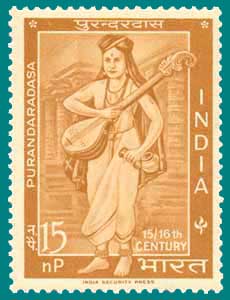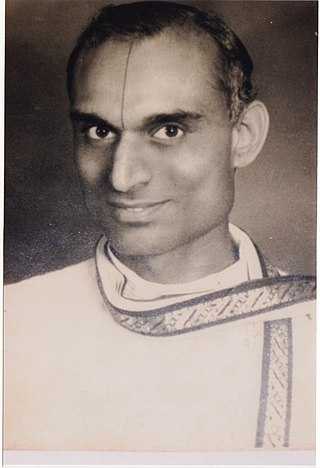
Carnatic music, known as Karnāṭaka saṃgīta or Karnāṭaka saṅgītam in the South Indian languages, is a system of music commonly associated with South India, including the modern Indian states of Andhra Pradesh, Karnataka, Kerala, Tamil Nadu and portions of east and south Telangana and southern Odisha. It is one of three main subgenres of Indian classical music that evolved from ancient Hindu texts and traditions, particularly the Samaveda. The other two sub gendered are Hindustani music, which emerged as a distinct form because of Persian or Islamic influences from Northern India and Odissi music from Odisha which dates back from 2000 years back based on Traditions in Jagannatha Temple. The main emphasis in Carnatic music is on vocal music; most compositions are written to be sung, and even when played on instruments, they are meant to be performed in gāyaki (singing) style.

Tallapaka Annamacharya, also popularly known as Annamayya, was a Telugu musician, composer, and a Hindu saint. He is the earliest known Indian musician to compose songs called samkirtanas. His devotional samkirtanas were in the praise of Venkateswara, a form of Vishnu. Annamayya is said to have composed as many as 32,000 samkirtanas (songs) in the praise of Venkateswara of which only about 12,000 are available today. He wrote the highest number of Kirtanas of all time in the praise of Lord Vishnu The musical form of the kirtana songs that he composed, which are still popular among Carnatic music concert artists, have strongly influenced the structure of Carnatic music compositions. His compositions are classified as Adhyatma (spiritual) and Sringara (romantic). Annamacharya is remembered for his saintly life, as one of the greatest musicians and is honoured as a great devotee of Vishnu by devotees and saintly singers. He was one of the first few who opposed the social stigma towards the untouchable castes in his era.

Srinivasa Nayaka, also known as Purandara Dasa was a composer, singer and a Haridasa philosopher from present-day Karnataka, India. He was a follower of Madhvacharya's Dvaita philosophy. He was one of the chief founding proponents of Carnatic music. In honor of his contributions to Carnatic music, he is referred to as the Pitamaha of Carnatic music. According to a legend, he is considered as an incarnation of Narada.

Muthuswami Dikshitar (Mudduswamy Dikshitar) (IAST: muttusvāmi dīkṣitar, 24 March 1776 – 21 October 1835), mononymously Dikshitar, was a South Indian poet, singer and veena player, and a composer of Indian classical music, who is considered one of the musical trinity of Carnatic music. Muthuswami Dikshitar was born on 24 March 1776 in Tiruvarur near Thanjavur, in what is now the state of Tamil Nadu in India, to a family that is traditionally traced back to Virinichipuram in the northern boundaries of the state.

Syama Sastri or Shyama Shastri was a musician and composer of Carnatic music. He was the oldest among the Trinity of Carnatic music, Tyagaraja and Muthuswami Dikshitar being the other two.

Subramaniam Lakshminarayana is an Indian violinist, composer and conductor, trained in the classical Carnatic music tradition and Western classical music.

Karnataka is a state of India with a long tradition of innovation in the fields of both Carnatic and Hindustani classical music.

Dharmapuri is a city in the north western part of Tamil Nadu, India. It serves as the administrative headquarters of Dharmapuri district which is the first district created in Tamil Nadu after the independence of India by splitting it from then Salem district on 2 October 1965. The city is located 50 km from Krishnagiri, 69 km from Salem, 60 km from Tirupattur, 90 km from Hosur, 117 km from Thiruvannamalai, 126 km from Bangalore and Erode, 181 km from Tiruppur, 200 km from Coimbatore and Tiruchirappalli, 300 km from Madurai and the state capital Chennai. It is located between latitudes N 11 47’ and 12 33’ and longitudes E 77 02’ and 78 40’. It is one of the major leading cultivators and producers of mangoes in the state along with Krishnagiri, and is often referred as Mango Capital of India.

Veenai Dhanammal (1867–1938) was a highly accomplished Carnatic musician, and the torchbearer of the school of Carnatic music that goes by her name. She was both a vocalist and a performer on the Saraswati veena. The prefix "Veenai" in her name is an indicator of her exceptional mastery of that instrument.

Lalgudi Gopala Iyer Jayaraman was an Indian Carnatic violinist, vocalist and composer. He is commonly grouped with M.S. Gopalakrishnan and T.N.Krishnan as part of the violin trinity of Carnatic music. He was awarded the Padma Bhushan by the Government of India in 2001.

Mysore Vasudevacharya was an Indian musician and composer of Carnatic music compositions who belonged to the direct line of Thyagaraja's disciples. Vasudevachar's compositions were mostly in Telugu and Sanskrit. Some of his most popular kritis include Broche varevaru ra in Khamas raga, Devadideva in Sunadavinodini, Mamavatu Sri Saraswati in Hindolam, Shankari Ninne in Pantuvarali, Bhajare Re Manasa in Abheri and Ra Ra Rajeevalochana Rama in Mohanam. He presided over Madras Music Academy's annual conference in 1935, when the Sangeetha Kalanidhi award did not exist. But everybody who presided over the annual conference in the 1930s was later conferred the award. He was a recipient of the civilian honour of the Padma Bhushan.
The Trinity of Carnatic Music, also known as the Three Jewels of Carnatic Music, refers to the outstanding trio of composer-musicians of Carnatic music in the 18th century—Tyagaraja, Muthuswami Dikshitar, and Syama Sastri. Prolific in composition, the Trinity of Carnatic music is known for creating a new era in the history of carnatic music by bringing about a noticeable change in what was the existing carnatic music tradition. Compositions of the Trinity of Carnatic music are recognized as being distinct in style, and original in handling ragas. All three composers were born in Thiruvarur, formerly part of Thanjavur District in Tamilnadu. M. S. Subbalakshmi, D. K. Pattammal, and M. L. Vasanthakumari, who are carnatic musicians of the 20th century, are popularly referred to as the female Trinity of Carnatic Music.
The Haridaasas, the Vaishnava saints of Karnataka, are classified into the Vyaasakuta and Daasakuta. The Vyaasakuta were the pontifical saints known for their scholarship and exposition of Madhva's philosophy. The Daasakuta were the peripatetic saint disciples of the Vyaasakuta sanyasins. They were proficient singers and composers and used classical music and the Kannada language as a medium to propagate the teachings and philosophy of the Dvaita school. While Sripadaraya is sometimes credited with starting this musical movement, Purandaradaasa, a disciple of Vyaasasraaya, became renowned as Karnataka Sangita Pitaamaha.
Manjapara Devesa Bhagavathar Ramanathan was a Carnatic music composer and vocalist who created a distinctive style of singing rich in Bhava and Laya. He was considered for the Madras Music Academy's Sangeetha Kalanidhi award in 1983. However, the award for that year was given to Sripada Pinakapani.
Samuel Joseph, better known as Shyam, is a music composer who works in Malayalam cinema.

Tripunithura Viswanathan Gopalakrishnan, known as TVG, is a Carnatic and Hindustani musician from Cochin, Kerala, India. He was awarded the Madras Music Academy's Sangeetha Kalanidhi in 2014.
Mavelikkara Krishnankutty Nair was a Carnatic Mridangam player. He received his training from Alleppey Venkappan Pillai and Veechur Krishna Iyer. He considered Palani Subramaniam Pillai as his 'Manasa Guru'. He received the Padma Shri from the President of India. He received the Kerala Sangeetha Nataka Akademi Award in 1971 and the Kerala Sangeetha Nataka Akademi Fellowship in 1980. Krishnankutty Nair was also an artiste for All India Radio in Trivandrum.

M. D. Parthasarathy was an Indian music composer and actor, who worked mainly in Tamil cinema.

Sidharth Sriram is an Indian Carnatic musician, music producer, playback singer. He is an R&B songwriter and has been working in the Tamil, Telugu, Kannada, Malayalam, Hindi, Marathi and English music industry. He regularly collaborates with his sister Pallavi Sriram, a Bharatanatyam dancer, and music director.













